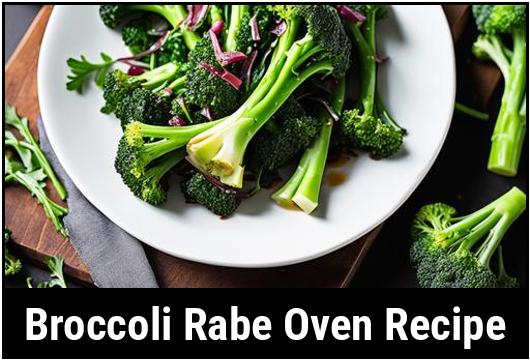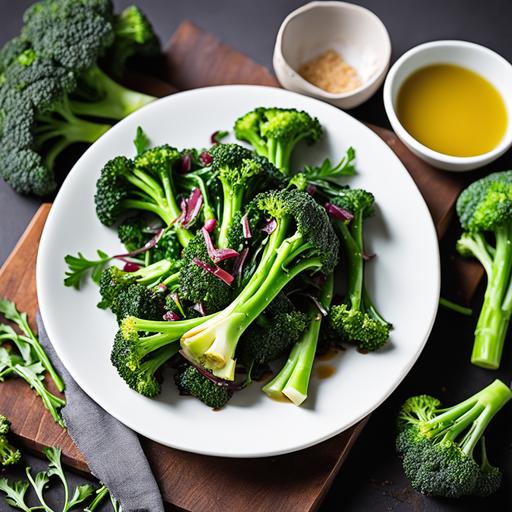
Broccoli Rabe Oven Recipe: A Comprehensive Guide To Deliciousness!
Are you looking to elevate your culinary skills and discover a new and exciting vegetable dish? Look no further than the incredible world of broccoli rabe oven recipes! Bursting with flavor and packed with nutrients, this versatile vegetable can make a delightful addition to your dinner table. In this comprehensive guide, we will delve into the food science, culinary details, selection, cleaning, preparation, tips, variations, doneness checks, recipe, and even touch on the common concerns of overcooking and undercooking. So let’s dive into the world of broccoli rabe and unleash your inner chef!
Understanding the Science behind Broccoli Rabe
Broccoli rabe, also known as rapini, is a leafy green vegetable that belongs to the same family as broccoli, cabbage, and kale. While it may resemble broccoli to some extent, it has a distinct bitter flavor that adds a pleasant contrast to various recipes. It is packed with vitamins A, C, and K, as well as essential minerals like calcium, magnesium, and iron.
When subjected to heat during cooking, broccoli rabe undergoes a breakdown process known as enzymatic browning. This process enhances the flavors and textures, resulting in a delicious and savory dish. So let’s explore how to select the perfect broccoli rabe for your recipe.
Selecting and Cleaning your Broccoli Rabe
When choosing broccoli rabe, look for bright green leaves with firm stems. Avoid wilted or yellowing leaves, as they indicate age and potential loss of freshness. Fresh broccoli rabe should have tender stems and crisp leaves. Additionally, opt for smaller bunches as they tend to be more tender and less bitter.
Cleaning broccoli rabe is an essential step in preparing it for cooking. Start by rinsing it under cold water to remove any dirt or debris. If necessary, gently rub the leaves to ensure a thorough cleaning. Once cleaned, use a knife or kitchen shears to trim the tough ends of the stems. Now it’s time to move on to the preparation stage!
Preparing Your Broccoli Rabe: Tips and Techniques

Preparing broccoli rabe is relatively simple, and with a few techniques, you can enhance its taste and texture. Firstly, blanching can help reduce the bitterness and improve its vibrant green color. To blanch, bring a pot of salted water to a boil and add the broccoli rabe. Cook it for about 2 minutes before transferring it to a bowl of ice water to halt the cooking process.
If you prefer to retain the bitter taste, skip the blanching step and move on to sautéing or roasting the broccoli rabe. These methods allow you to bring out the natural flavors and textures of the vegetable while adding complementary ingredients.
Sautéing and Roasting: Flavorful Variations
When sautéing broccoli rabe, it’s important to control the heat to avoid overcooking. Heat a pan over medium heat and add a drizzle of olive oil or butter. Toss in some minced garlic or shallots for an added aromatic touch. Then, add the blanched or fresh broccoli rabe and sauté for about 5-7 minutes until it’s tender yet still slightly crisp. Season with salt, pepper, and lemon juice for a burst of freshness.
Roasting broccoli rabe takes the flavors to a whole new level. Preheat your oven to 400°F (200°C), and spread the cleaned and trimmed broccoli rabe on a baking sheet. Drizzle with olive oil, sprinkle with salt and pepper, and add your favorite seasonings, such as smoked paprika or chili flakes. Roast for approximately 15-20 minutes, allowing the edges to become delightfully crispy while maintaining a slightly tender center.
Checking for Doneness: Achieving Perfection

Properly determining the doneness of your broccoli rabe is crucial to ensure a perfect dish. It should be tender enough to bite into without losing its vibrant green color. When sautéing, keep a close eye on the vegetable – if it turns brown or wilts excessively, it may be overcooked. Similarly, when roasting, check for a slight crispness on the edges while maintaining its fresh green appearance.
To check for doneness, taste a small piece of the stalk or leaf. It should be tender but still have a gentle bite. Don’t be afraid to experiment and adjust the cooking time to suit your personal preferences. Remember, practice makes perfect!
Delicious Broccoli Rabe Oven Recipe: Let’s Get Cooking!
Now that you understand the culinary details, cleaning, preparation, and different cooking techniques, let’s dive into a mouthwatering broccoli rabe oven recipe that will leave your taste buds dancing! This recipe combines the roasting technique with a delightful blend of flavors. Here’s what you’ll need:
Ingredients:
-
1 lb (450g) broccoli rabe, cleaned and trimmed
-
2 tablespoons olive oil
-
3-4 cloves of garlic, minced
-
1 teaspoon lemon zest
-
Salt and pepper to taste
Instructions:
-
Preheat your oven to 400°F (200°C).
-
Place the cleaned and trimmed broccoli rabe on a baking sheet.
-
Drizzle olive oil over the vegetables, ensuring each piece is coated.
-
Sprinkle with minced garlic, lemon zest, salt, and pepper, evenly distributing the seasonings.
-
Toss the broccoli rabe gently to coat it with the oil and seasonings.
-
Spread the broccoli rabe in a single layer, making sure not to overcrowd the baking sheet.
-
Roast in the preheated oven for 15-20 minutes, or until the edges turn slightly crispy and the broccoli rabe is tender but still vibrant green.
-
Remove from the oven and let it cool for a minute.
-
Serve as a side dish or toss it in your favorite pasta or grain bowl.
A Word of Caution: Avoid Overcooking and Undercooking
While experimenting in the kitchen is fun, it’s important to avoid the common pitfalls of overcooking or undercooking broccoli rabe. Overcooking can result in a mushy texture and loss of vibrant color, while undercooking may leave the vegetable tough and bitter.
To prevent overcooking, keep a close eye on the broccoli rabe while using either sautéing or roasting techniques. Adjust the cooking time as needed, and remember that the vegetable should still retain a slight crispness.
On the other hand, undercooking can lead to a bitter taste and an unpleasant texture. Make sure to taste your dish during the cooking process to determine when it reaches the desired tenderness, as we know everyone’s preferences differ.
Conclusion
Congratulations! You’ve embarked on a culinary journey through the fascinating world of broccoli rabe oven recipes. From understanding the food science to selecting, cleaning, preparing, and cooking this delightful vegetable, you’re now equipped to create a variety of delicious dishes. Whether you opt for the sautéing or roasting method, remember to experiment, adjust cooking times to your taste, and enjoy the process.
The versatility of broccoli rabe allows it to shine as a vibrant side dish or a delightful addition to pasta, grain bowls, and even sandwiches. So, the next time you’re in the kitchen, embrace the flavors and colors of this nutritious vegetable and let your creativity run wild. Happy cooking!
Sources
FAQS On Broccoli Rabe Oven Recipe
What Is Broccoli Rabe?
Broccoli rabe, also known as rapini, is a leafy green vegetable that is part of the brassica family, along with broccoli, cauliflower, and Brussels sprouts. It has long, thin stalks and small broccoli-like buds, and has a slightly bitter and nutty flavor.
How Do I Prep Broccoli Rabe For Cooking?
Start by trimming the tough ends of the stalks, and then chop the remaining stems and leaves into bite-sized pieces. You can also blanch the broccoli rabe for a minute to soften the bitter taste before cooking with it.
What Types Of Dishes Can I Make With Broccoli Rabe?
Broccoli rabe is a versatile ingredient that can be used in a variety of dishes, such as sautéed with garlic and olive oil, added to pasta or risotto, and roasted in the oven. It can also be used in soups, as a pizza topping, or in salads.
How Do I Cook Broccoli Rabe In The Oven?
Preheat your oven to 375 degrees Fahrenheit. Toss the broccoli rabe with olive oil, salt, and pepper, and spread it evenly on a baking sheet. Bake for about 20 minutes, stirring halfway through, until the stalks are tender and the tops are slightly crispy.
Are There Any Variations To This Oven Recipe?
Yes, you can add other ingredients to the broccoli rabe before baking, such as garlic, Parmesan cheese, red pepper flakes, or lemon juice. You can also use this recipe as a base and add the roasted broccoli rabe to other dishes, such as a frittata or a grain bowl.



